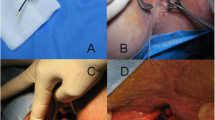Abstract
Background
Optimal treatment for high/complex anal fistulas is uncertain. We have studied one surgeon’s results over a ten-year period, concentrating on high fistulas.
Methods
Demographic, fistula anatomy and treatment data were recorded for all patients undergoing surgery for anal fistula. Outcome data were recorded for patients who had been followed up for a minimum of 4 weeks.
Results
One hundred and eighty patients were studied. Outcome data were available for 52 low and 84 high fistulas. Fistulotomy was performed for 50 low and 48 high fistulas, with closure rates of 98 and 96%, respectively. There was fistula recurrence in two patients with high fistulas. Symptoms of sphincter disturbance were similar after lay open of low and high fistulas. Treatment of a high fistula by drainage seton had a lower rate of inadvertent passage of flatus but a similar rate of minor soiling compared with fistulotomy.
Conclusions
Lay open of low and high anal fistulas is effective and associated with a similar, predictable rate of minor sphincter disturbance, amounting to a third to one quarter of patients with mild leakage of flatus and mucus. Patients with high fistulas can be cured, but when a surgeon is in doubt, a second opinion at an expert centre should be sought before definitive intervention.





Similar content being viewed by others
References
Parks AG, Gordon PH, Hardcastle JD (1976) A classification of fistula-in-ano. Br J Surg 63:1–12
Cirocco WC, Reilly JC (1992) Challenging the predictive accuracy of Goodsall’s rule for anal fistulas. Dis Colon Rectum 35:537–542
Zanotti C, Martinez-Puente C, Pascual I, Pascual M, Herreros D, Garcia-Olmo D (2007) An assessment of the incidence of fistula-in-ano in four countries of the European Union. Int J Colorectal Dis 22:1459–1462
Rojanasakul A (2009) LIFT procedure: a simplified technique for fistula-in-ano. Tech Coloproctol 13:237–240
Yeung JM, Simpson JA, Tang SW, Armitage NC, Maxwell-Armstrong C (2010) Fibrin glue for the treatment of fistulae in ano—a method worth sticking to? Colorectal Dis 12:363–366
Perez F, Arroyo A, Serrano P et al (2006) Randomized clinical and manometric study of advancement flap versus fistulotomy with sphincter reconstruction in the management of complex fistula-in-ano. Am J Surg 192:34–40
Amrani S, Zimmern A, O’Hara K, Corman ML (2008) The Surgisis AFP anal fistula plug: a new and reasonable alternative for the treatment of anal fistula. Gastroenterol Clin Biol 32:946–948
Shanwani A, Nor AM, Amri N (2010) Ligation of the intersphincteric fistula tract (LIFT): a sphincter-saving technique for fistula-in-ano. Dis Colon Rectum 53:39–42
Ho KS, Ho YH (2005) Controlled, randomized trial of island flap anoplasty for treatment of trans-sphincteric fistula-in-ano: early results. Tech Coloproctol 9:166–168
Chung W, Kazemi P, Ko D et al (2009) Anal fistula plug and fibrin glue versus conventional treatment in repair of complex anal fistulas. Am J Surg 197:604–608
Gonzalez-Ruiz C, Kaiser AM, Vukasin P, Beart RW Jr, Ortega AE (2006) Intraoperative physical diagnosis in the management of anal fistula. Am Surg 72:11–15
Lunniss PJ, Kamm MA, Phillips RK (1994) Factors affecting continence after surgery for anal fistula. Br J Surg 81:1382–1385
Ommer A, Wenger FA, Rolfs T, Walz MK (2008) Continence disorders after anal surgery—a relevant problem? Int J Colorectal Dis 23:1023–1031
Zbar AP, Ramesh J, Beer-Gabel M, Salazar R, Pescatori M (2003) Conventional cutting vs. internal anal sphincter-preserving seton for high trans-sphincteric fistula: a prospective randomized manometric and clinical trial. Tech Coloproctol 7:89–94
van der Hagen SJ, Baeten CG, Soeters PB, Beets-Tan RG, Russel MG, van Gemert WG (2005) Staged mucosal advancement flap for the treatment of complex anal fistulas: pretreatment with noncutting setons and in case of recurrent multiple abscesses a diverting stoma. Colorectal Dis 7:513–518
Buchanan GN, Bartram CI, Phillips RK et al (2003) Efficacy of fibrin sealant in the management of complex anal fistula: a prospective trial. Dis Colon Rectum 46:1167–1174
Safar B, Jobanputra S, Sands D, Weiss EG, Nogueras JJ, Wexner SD (2009) Anal fistula plug: initial experience and outcomes. Dis Colon Rectum 52:248–252
Rosa G, Lolli P, Piccinelli D, Mazzola F, Bonomo S (2006) Fistula in ano: anatomoclinical aspects, surgical therapy and results in 844 patients. Tech Coloproctol 10:215–221
Vaizey CJ, Carapeti E, Cahill JA, Kamm MA (1999) Prospective comparison of faecal incontinence grading systems. Gut 44:77–80
Jorge JM, Wexner SD (1993) Etiology and management of fecal incontinence. Dis Colon Rectum 36:77–97
Author information
Authors and Affiliations
Corresponding author
Rights and permissions
About this article
Cite this article
Atkin, G.K., Martins, J., Tozer, P. et al. For many high anal fistulas, lay open is still a good option. Tech Coloproctol 15, 143–150 (2011). https://doi.org/10.1007/s10151-011-0676-6
Received:
Accepted:
Published:
Issue Date:
DOI: https://doi.org/10.1007/s10151-011-0676-6




